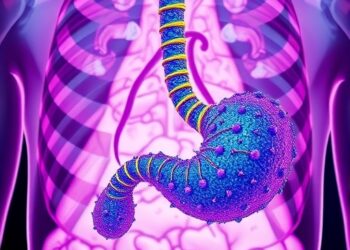A recent study has unveiled a pivotal connection between the hormone adrenomedullin and insulin resistance, which plays a significant role in the development of type 2 diabetes, particularly in the context of obesity. This groundbreaking research highlights the intriguing mechanisms through which adrenomedullin interferes with insulin signaling in endothelial cells, crucial components of the vascular system. This disruption ultimately contributes to systemic insulin resistance, a hallmark of type 2 diabetes that impacts millions globally.
Insulin resistance is primarily characterized by the impaired response of cells to insulin, a hormone essential for glucose metabolism. The body’s inability to effectively utilize insulin often leads to elevated blood sugar levels, setting the stage for diabetes-related complications. While insulin resistance traditionally has been associated with skeletal muscle, liver, and adipose tissue dysfunction, emerging evidence suggests that endothelial cells also play a crucial role in this metabolic disorder. Endothelial cells line the blood vessel walls and possess insulin receptors, thereby making them integral to the body’s insulin response.
In observations made on both obese mice and humans, researchers noted elevated levels of adrenomedullin and complement factor H, a protein that enhances the action of adrenomedullin. These elevated levels correlate with the onset of insulin resistance, particularly within blood vessel cells, underscoring the potential for these factors to serve as biomarkers for metabolic disorders. Notably, adrenomedullin’s ability to hinder insulin signaling in endothelial cells suggests a novel pathway through which obesity exacerbates insulin resistance, complicating the overall management of diabetes.
The study, led by Haaglim Cho and colleagues, employed mouse models to elucidate the mechanisms at play. Experimentation showed that when lean mice were administered adrenomedullin, they exhibited insulin resistance similar to that seen in obese counterparts. This finding not only underscores the direct impact of adrenomedullin on insulin signaling but also highlights the potential implications for therapeutic interventions targeting this hormone.
Importantly, the study demonstrated that mice deficient in adrenomedullin receptors did not develop insulin resistance when exposed to the hormone. This crucial observation confirms the significance of adrenomedullin’s action through specific receptors on endothelial cells, offering a clear target for future research and potential therapies. By blocking adrenomedullin signaling, researchers observed improved insulin function and enhanced blood flow in skeletal muscles of obese mice, suggesting that such interventions could mitigate some of the complications associated with obesity-related diabetes.
The implications of these findings extend far beyond basic science; they open new avenues for understanding the complex interplay between hormones and metabolic disorders. As diabetes continues to be a leading cause of morbidity and mortality worldwide, identifying key players such as adrenomedullin and CFH provides vital insights into possible treatment strategies. The research community is now urged to explore therapeutic agents that might counteract the adverse effects of adrenomedullin, potentially restoring proper insulin function and glucose metabolism.
Chronic conditions like obesity are increasingly linked to a myriad of systemic health challenges, including cardiovascular disease and inflammatory disorders. Therefore, unraveling the underlying mechanisms of insulin resistance offers a dual advantage—it not only aids in diabetes management but may also reveal insights into other related health concerns. The study by Cho et al. serves as a significant contribution to this understanding, proposing adrenomedullin as a critical mediator in the metabolic dysfunction associated with obesity.
As research progresses, scientists are hopeful that interventions targeting adrenomedullin could revolutionize the treatment landscape for diabetes. The potential to enhance insulin sensitivity through the modulation of this hormone signifies a new frontier in metabolic disease management. Researchers are encouraged to push forward with clinical trials that assess the efficacy of adrenomedullin antagonists or other strategies aimed at mitigating its effects on insulin signaling.
Furthermore, understanding how other hormones interact with adrenomedullin may yield additional insights into overall metabolic health. Given the complex nature of hormonal regulation, studies examining the interplay between various metabolic signals will be essential in crafting a holistic approach to treating obesity-related insulin resistance. The medical community stands at the precipice of a breakthrough that could reshape how we view and treat metabolic disorders associated with obesity.
In conclusion, as this study suggests, targeting adrenomedullin and its signaling pathways may represent a promising strategy to counteract the pervasive issue of insulin resistance in obesity. With ongoing research, the possibility of translating these findings into clinical practice could bring hope to millions grappling with the challenges of type 2 diabetes and its associated health burdens.
Subject of Research: Adrenomedullin’s role in insulin resistance and type 2 diabetes
Article Title: Endothelial insulin resistance induced by adrenomedullin mediates obesity-associated diabetes
News Publication Date: 7-Feb-2025
Web References: http://dx.doi.org/10.1126/science.adr4731
References: Relevant studies and articles will be indexed in the Science journal.
Image Credits: Science Journal
Keywords: Adrenomedullin, insulin resistance, type 2 diabetes, obesity, endothelial cells, metabolic dysfunction, hormone signaling, complement factor H, glucose metabolism, therapeutic targets, chronic disease.




